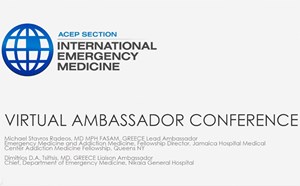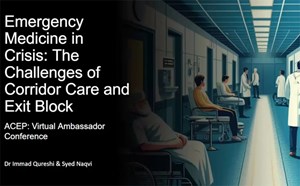Ultrasound in Emergency Medicine: Evolution in Ecuador
Watch this International EM Section Virtual Ambassador Conference webinar covering emergency medicine in Ecuador. Dr. Augusto Maldonado presents.
Read the Full Transcript
- Ecuador is a country in the west coast of South America. We have 17 million people population. And the emergency medicine specialty was recognized in 1993. So now we have around 500 emergency physicians in our country, but most of them in the main cities. So the rural areas doesn't have a lot of emergency medicine physicians. As I hear the last presentations, I think in countries like Ecuador, we have the same problems, so we have to address some of them. In this time, I choose the ultrasound as the topic of this update because we have interesting evolution in our country. Let me take you there. Next slide, please. So this, maybe this start before 2006. When we were working as emergency physicians in 1997, we have the idea that ultrasound could change the emergency medicine practice. So after some contacts in the United States, we started teaching, not formally, but in the postgraduate programs. And in 2007, the government and the Ministry of Health bought a lot of ultrasound machines, and they place these machines in the rural areas, in the hospitals in the rural areas. But nobody could utilize these machines, and they were underutilized. But in 2006, we have many postgraduate colleagues that have to go to the rural areas to pay their scholarships. So they start using the ultrasound machines and that was the beginning of the practice of ultrasound and the practice and the applications of ultrasound all around the country. In 2008, we start with a group of emergency physicians, during the next eight years teaching ultrasound in emergency medicine, and we teach, we train 800 physicians all around the country. So that was good because the ultrasound applications were best used in the different hospitals, not only in the main cities, but also in the rural areas. In 2014, we have formally included in the curriculum of the postgraduate programs, and the National Council of Superior Education in our country approved this in 2015. Next slide, please. In 2010, in different hospitals, especially in Quito, which is the capital of Ecuador, we were using in all the applications recommended by the ACEP policy and guidelines. So it was, we continue using these guidelines until today. In 2015 there were a lot of courses that came from international, international courses and master's degree for ultrasound. But they were so expensive and the emergency physicians could not afford them. In 2022, two years ago, we had an agreement with ONDAS Latinoamericana to start doing the fellowship in ultrasound, and we are now going through the second cohort. And this is very interesting for us because it's the initiation of programs of ultrasound not only for emergency physicians, but for another kind of specialists. Next slide, please. Well, you can see here one of the known courses international is Winfocus and some other masters online. They came to our country. They were very expensive. Some people could do it, but most of the emergency physicians couldn't, and they didn't have any kind of follow up. So this new fellowship that we have an agreement, we can grow with the emergency physicians, and it doesn't have any cost for our specialists. And the objective of this or the goal of this fellowship is to have here and without any cost in the country, moving, like in Peru. I guess in Peru, they have a huge program of ultrasound in emergency medicine that is growing each time. For the next, in the next year, we will have the program of pre-graduate ultrasound at the University San Francisco de Quito, which is the first one to do it officially. Next one. So in summary, we have seven programs in Ecuador. Ultrasound is very important. It's part of the curriculum. In areas with the low resources, I think it's a very useful tool because in some hospitals we don't have CT or MRI, and ultrasound can help not in in all the topics, but can help a lot to make a diagnosis, procedures and some other applications. And especially in countries like our, it's very important to develop this part of the emergency medicine. We don't have a lot or enough supervisors in ultrasound. So that's a huge problem that we have to resolve. And all of the programs in emergency medicine also have hospital practice, so the supervisors in this setting is very important to train. The follow-up after the courses, I think it's very important because it's a practical tool. So we have to be sure that everybody can apply correctly this very nice tool. Next slide. Thanks for your attention.



